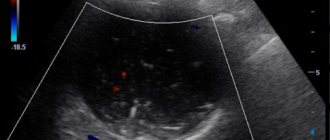Pericarditis is inflammation of the outer lining of the heart. Most often it is infectious, rheumatic or post-infarction. Pericarditis has the following symptoms:
- Weakness;
- Constant pain behind the sternum, which intensifies when inhaling;
- Cough;
- Severe shortness of breath.
Pericarditis occurs with fluid leaking between the pericardial layers (observed with exudative pericarditis). This pathology is dangerous due to the development of suppuration and cardiac tamponade (when accumulated fluid compresses the heart and blood vessels) and may require immediate surgical intervention.
Pericarditis can be a symptom of a systemic, infectious, cardiac disease, as well as a complication of various pathologies of internal organs or injuries. Often it is pericarditis that becomes of paramount importance in the clinical picture of the disease, and other manifestations of pathology fade into the background. Diagnosis of pericarditis is not always made while the patient is alive; in approximately 4–7% of cases, signs of past pathology are determined only at autopsy. Pericarditis can occur at any age, but, as a rule, occurs among the adult and elderly population, and the incidence of pericarditis in females is higher than in males.
With serous pericarditis, the inflammatory process spreads to the serous tissue membrane of the heart (parietal, visceral plate and pericardial cavity). Permeability increases and blood vessels dilate, leukocytes infiltrate, fibrin is deposited, adhesions are added and scars are formed, pericardial layers become calcified and the heart is compressed.
Pericarditis has the following causes:
- Rheumatism (endocarditis and myocarditis are also affected);
- Tuberculosis (when infection spreads from foci in the lungs through the lymphatic ducts to the lymph nodes.)
Both diseases are manifestations of an infectious-allergic process.
Certain conditions increase the risk of developing pericarditis, including:
- Infectious and viral diseases - influenza, measles;
- Bacterial processes - tuberculosis, tonsillitis, scarlet fever;
- Sepsis;
- Fungal and parasitic infection;
- Pneumonia;
- Pleurisy;
- Endocarditis (lymphogenous or hematogenous route);
- Allergic damage (serum sickness, drug allergy);
- Systemic connective tissue diseases (lupus erythematosus, rheumatoid arthritis, rheumatism and others);
- Heart pathologies (myocardial infarction, endocarditis or myocarditis);
- Surgical interventions;
- Malignant processes;
- Metabolic disorders (toxic effects due to uremia and gout);
- Radiation damage;
- Heart malformations (pericardial cysts and diverticula);
- Edema;
- Hemodynamic disturbances (as a result, fluid accumulates in the pericardial space).
At the Yusupov Hospital, patients with pericarditis are provided with all types of treatment by highly qualified doctors. Specialists collect all anamnestic data in detail and conduct diagnostic studies using the latest equipment. The staff of the Yusupov Hospital takes care of their clients not only in a hospital setting, so patients with pericarditis are given precise clinical recommendations after discharge.
Why does pericarditis occur?
The following are the main causes of pericarditis:
- Infectious agents: viruses, bacteria, fungi and even parasites. The inflammatory process in the pericardium is triggered by the influence of exo- and endotoxins released by microorganisms.
- Autoimmune connective tissue diseases such as lupus erythematosus or scleroderma. At the same time, the body synthesizes antibodies to its own cells, which damage connective tissue and cause systemic inflammation.
- Heart diseases. The result of serious damage to the heart muscle is the spread of the pathological process to the surrounding pericardium. This can occur with transmural myocardial infarction, infectious or reactive myocarditis.
- Damage to other organs, such as the kidneys, can lead to pericarditis. In cases of serious impairment of excretory function and the formation of renal failure, deposition of metabolic products in the serous cavities, including the pleura and pericardium, is observed.
- Penetrating pericardial injuries that disrupt the integrity of the pericardial layers.
- Metastatic tumors that cause pericardial carcinomatosis.
- The causes of pericarditis are varied, and, therefore, treatment approaches depend on what caused the inflammation. But in the absence of timely diagnosis and correction of this condition, the outcome is always the same. The result of chronic pericarditis is cardiac tamponade, which leads to the death of the patient.
At CELT you can consult a cardiologist.
- Initial consultation – 3,500
- Repeated consultation – 2,300
Make an appointment
Causes of pericarditis in adults
The cause of most pericarditis is unknown, but 80 to 90% of cases are thought to be associated with infections (viruses, bacteria, fungi, and parasites).
In addition, pericarditis can be caused by:
- cardiovascular problems (previous heart attack or surgery);
- injuries;
- radiation therapy;
- autoimmune diseases such as lupus;
- some medications, which is rare;
- metabolic disorders such as gout;
- renal failure;
- some genetic diseases, such as familial Mediterranean fever;
- cancer;
- some medications.
What are the types of pericarditis?
According to the pathophysiological mechanism, pericarditis is divided into:
- exudative pericarditis (when inflammatory fluid accumulates in the cavity - exudate);
- adhesive pericarditis (when “dry” inflammation predominates and adhesions form);
- constrictive pericarditis (when compression of the heart occurs and calcification of the pericardial walls).
This division is very arbitrary, because at different stages of the pathological process the type of inflammation can transform. And the formation of areas of calcification is the outcome of any pericarditis in the absence of adequate therapy.
Diagnostics
Other tests used for diagnosis include:
- a chest x-ray, which shows the shape of the heart and possible excess fluid;
- an electrocardiogram (ECG) to check your heart rhythm and see if the voltage signal is decreasing due to excess fluid;
- an echocardiogram, which will also show the shape, size of the heart and fluid accumulation;
- MRI;
- computed tomography, which provides a detailed image of the heart and pericardium;
- right heart catheterization, which will provide information about the pressure in the heart;
- blood tests to look for inflammatory markers that indicate pericarditis.
Symptoms of pericarditis
The onset of pericarditis, symptoms and first signs are quite characteristic. The main reason to see a doctor is chest pain. The pain syndrome in this disease can be quite pronounced and persistent. But there are times when fever comes first in severity. Its combination with shortness of breath and chest pain is often mistaken for pneumonia.
The pain syndrome in this cardiac pathology can radiate, as with angina pectoris, to the left arm and shoulder blade. But the hallmark of pain with pericarditis is the lack of connection with physical activity. The pain is almost constant and intensifies when changing body position or taking a deep breath.
In addition to pain, pericarditis is always accompanied by additional symptoms: general weakness, increased body temperature, shortness of breath with little physical exertion, interruptions in heart function, and decreased blood pressure. Unlike angina, nitrate-based medications do not provide relief.
If you notice similar symptoms in yourself or your loved ones, you need to urgently consult a doctor, because the price of delay can be human life. Only a professional cardiologist, having examined the patient and prescribed an immediate instrumental examination, will be able to accurately diagnose and recommend adequate treatment.
Otherwise, if medications are not prescribed in a timely manner, a terrible complication inevitably arises - cardiac tamponade. With tamponade, a large amount of exudate accumulates in the pericardial cavity. The consequence is that the heart muscle is literally compressed and cannot fully contract.
The result of such compression is acute cardiovascular failure, cardiac arrest and death of the patient. In this case, the usual methods of resuscitation rarely have a positive effect, and only the release of the pericardium from the excess amount of exudative fluid can make the heart beat again.
Types and stages of the disease
Armored heart develops for various reasons and has different classifications. According to the type of course of the disease, there are 2 stages:
- acute – the disease lasts no more than 2 months;
- chronic – the disease lasts up to six months.
The stages also have a separate classification.
In the acute stage, pericarditis is divided into:
- dry or fibrinous pericarditis is characterized by a small volume of fluid in the pericardium;
- effusion or exudative is characterized by the release and accumulation of fluid of varying consistency in the pericardial sac. Exudate exudate is divided into: serous-fibrous pericarditis (a mixture of liquid and thick, can resolve in small quantities);
- hemorrhagic (exudate consisting of blood), occurs with tuberculous inflammation: with tamponade (with a strong increase in the amount of fluid, serious disturbances in the functioning of the heart can occur);
- without tamponade:
The armored heart in the chronic stage has the following classification:
- effusion or exudative;
- adhesive (sticky) – diagnosed for complications of various pericarditis. As a result of the transition to the chronic form, scars form on the tissues of the pericardium, the leaves of which stick together, forming adhesions: occurring without pronounced symptoms;
- with impaired heart function;
- with the formation of calcium salts in the pericardial sac;
- constrictive;
- with the appearance of inflammatory granulomas:
In addition, pericarditis of non-inflammatory origin is diagnosed:
- hydropericardium – characterized by the accumulation of exudate in the pericardium due to chronic heart failure. Can be diagnosed in utero. Using ultrasound diagnostics, the doctor can identify hydropericardium in the fetus, which occurs due to a developmental defect or hemolytic edema;
- hemopericardium - characterized by the appearance of blood in the pericardial sac as a result of penetrating heart injury or rupture of an aneurysm;
- chylopericardium - the presence of chylous fluid in the pericardial space;
- pneumopericardium is diagnosed when there is air in the pericardium due to injury to the heart;
- effusion due to gout and uremia.
The disease is also divided according to the presence of fluid and its behavior:
- dry is characterized by a decrease in the amount of fluid or its stagnation;
- fibrinous pericarditis is characterized by a slight increase in fluid, as well as an increase in the level of protein in it;
- exudative. Exudate in the heart is contained in a large volume.
Treatment of pericarditis
The following groups of drugs are used in the treatment of pericarditis:
- Non-steroidal anti-inflammatory drugs that relieve the symptoms of inflammation.
- Antibiotics, antiviral, antifungal and antiparasitic drugs, if the etiological factor is an infectious agent.
- Glucocorticosteroids and cytostatics, if the cause of pericarditis is an autoimmune pathology.
- Treatment of the underlying disease that caused pericarditis - in case of renal failure, hemodialysis can be used, and in case of myocardial infarction - thrombolysis and restoration of blood flow through the coronary arteries.
- If there is a threat of developing cardiac tamponade, they resort to puncture of the pericardial cavity. The purpose of this manipulation is to remove fluid and prevent tamponade. But this puncture is no less important in diagnostic terms. The resulting exudate is subjected to microscopy, bacteriological and cytological examination. It can contain atypical tumor cells or an infectious pathogen.
The prognosis for pericarditis is generally favorable. If pericarditis is correctly diagnosed and treatment is started on time, then a complication in the form of tamponade is extremely unlikely. But it is worth remembering that pericarditis, the treatment of which requires a professional approach, is a rather formidable disease with dangerous complications.
By contacting CELT cardiologists, you can be absolutely sure of timely diagnosis and correct treatment tactics for any cardiac pathology. After all, we employ specialists of the highest category with extensive practical experience. Another argument in favor of CELT is that our clinic has the technical capabilities for a full and comprehensive examination.
Make an appointment through the application or by calling +7 +7 We work every day:
- Monday—Friday: 8.00—20.00
- Saturday: 8.00–18.00
- Sunday is a day off
The nearest metro and MCC stations to the clinic:
- Highway of Enthusiasts or Perovo
- Partisan
- Enthusiast Highway
Driving directions
Causes
The causes of pericarditis are divided into infectious and aseptic. Commonly encountered diseases include rheumatism and tuberculosis. Rheumatism affects not only the pericardium.
Pericarditis caused by these diseases is infectious or allergic in nature.
In tuberculosis, the infection penetrates the pericardium through lymph from the lungs.
Fluid also accumulates in the pericardium when:
- with the penetration of microbes, viruses, fungi;
- heart attack;
- elevated cholesterol levels, hormonal imbalances;
- various types of injuries in the heart area;
- tumors and neoplasms of various types, located directly on or near the heart.
Provoking factors for the development of pericarditis
Factors that increase the risk of disease include:
- infections of various etiologies (viral and bacterial). Quite often, the inflammatory process penetrates from organs close to the heart;
- various types of allergic reactions;
- lupus erythematosus, rheumatism, rheumatoid arthritis;
- heart disease;
- various damages and injuries in the heart area;
- malignant neoplasms;
- changes in metabolic processes;
- pathological structure of the pericardium;
- general edema and hemodynamic changes.
VitaPortal - website about health
We provide information under the following main sections.
- News of health, nutrition, diets and healthy lifestyles
- Proper nutrition, weight loss, diets
- Allergies and new treatments
- Bad habits and ways to give them up
- Human diseases, diagnostic and treatment methods
- Having and raising children
- Sports and fitness
- Healthy food recipes
- Free consultations with doctors
- Blogs of doctors, nutrition and fitness experts, interest groups
- Online appointment service with a doctor EMIAS
The concept of armored heart and the causes of pathology
Armored heart or pericarditis is an inflammation of the outer lining of the organ. The condition is characterized by severe pain in the chest, which intensifies with coughing and inhalation, or shortness of breath with the exudation of fluid between the pericardial layers, which leads to suppuration and a complication such as cardiac tamponade. Often the diagnosis is made posthumously. Why pathology develops and how to recognize it in time.
Physical examination
Upon external examination, attention is drawn to acrocyanosis (earlobes, nasolabial triangle, fingers acquire a bluish tint to the skin), which becomes more expressive in a horizontal position of the body; swelling of the neck veins, puffy face, enlarged abdomen due to fluid accumulation (ascites) and enlarged liver. As the disease progresses, the symptoms of circulatory failure progress. Shortness of breath becomes more pronounced, ascites increases.
Not only the liver, but also the spleen enlarges. “Pseudocirrhosis” develops, indicating the presence of liver failure. An increase in venous pressure leads to the fact that the neck and face become swollen, and the skin becomes bluish in color. This sign is called Stokes collar in medicine. Upon further examination, the borders of the heart are not enlarged, a pericardial friction murmur, a gallop rhythm are heard, heart sounds are muffled, the pulse is frequent and has weak filling.
How to recognize pathology
Early detection allows you to avoid the development of life-threatening complications. Diagnosis in the early stages of the exudative type with acute tamponade, as well as compressive tumor and purulent varieties, is especially important. It is necessary to determine the cause of inflammation and differentiate it from acute conditions (myocarditis, heart attack). Diagnostics consists of:
- general examination and medical history;
- blood test (general, biochemistry, immunology);
- phonocardiography;
- ECG;
- MRI CT, MSCT;
- fluorography, echocardiography.
Complications
Pericarditis often leads to serious complications if treatment is delayed.
With the exudative form of this disease, acute tamponade may occur.
With constructive circulatory failure quite often occurs, fluid compresses the vena cava and hepatic veins, the atrium, which causes insufficiency of ventricular diastole, and false cirrhosis of the liver can develop.
Fusion of the myocardium with nearby organs and the chest may also occur due to the formation of scar tissue.
Armored heart: symptoms and treatment
The causes of the development of armored heart can be rheumatoid arthritis, rheumatism, infections (rickettsia, protozoa, fungi, mycobacterium tuberculosis, bacteria, viruses), myocardial infarction, systemic lupus erythematosus, trauma, uremia, vitamin deficiencies B1 and C, tumors.
The mechanism of development of the armored heart is most often autoimmune or allergic.







